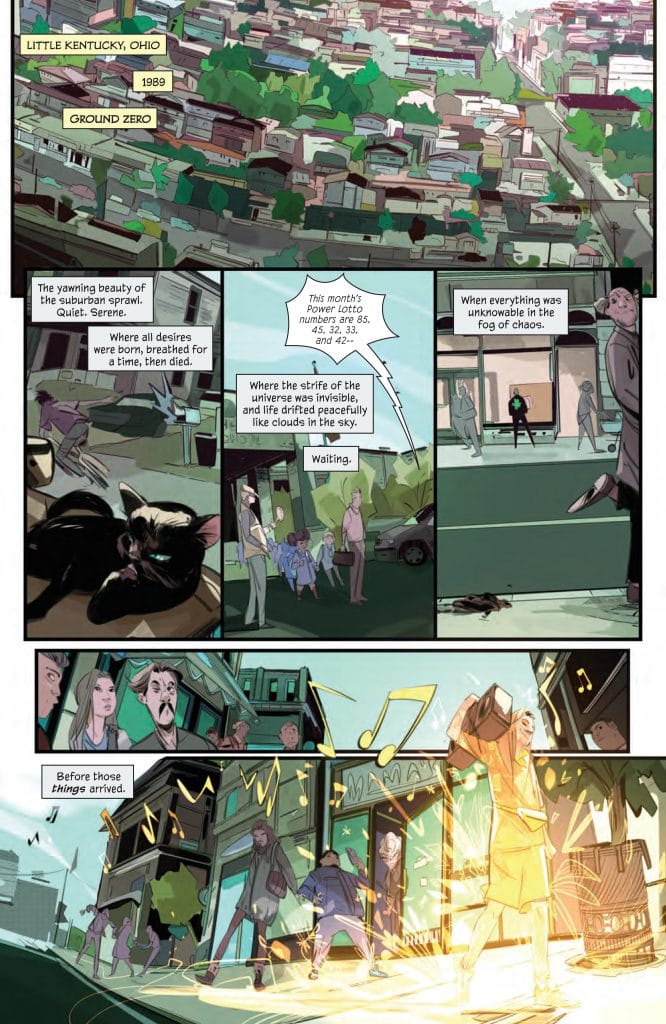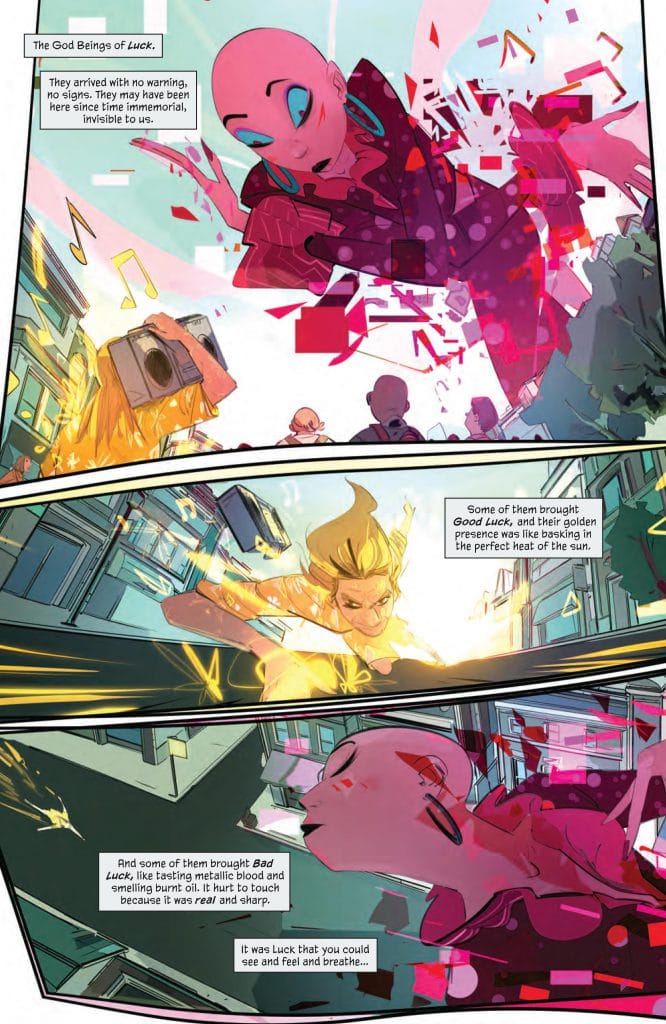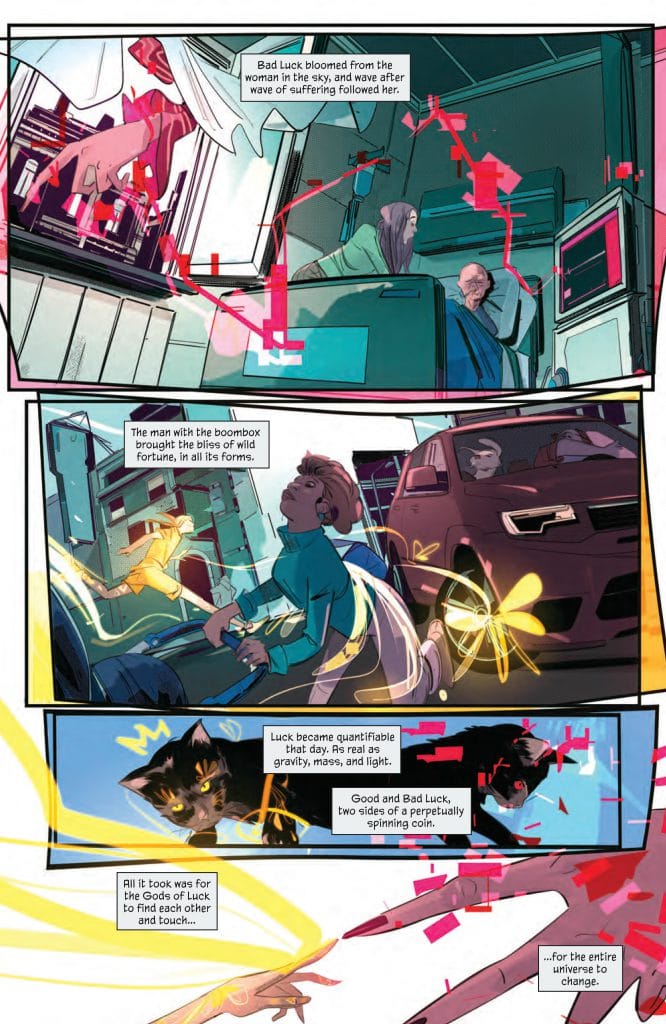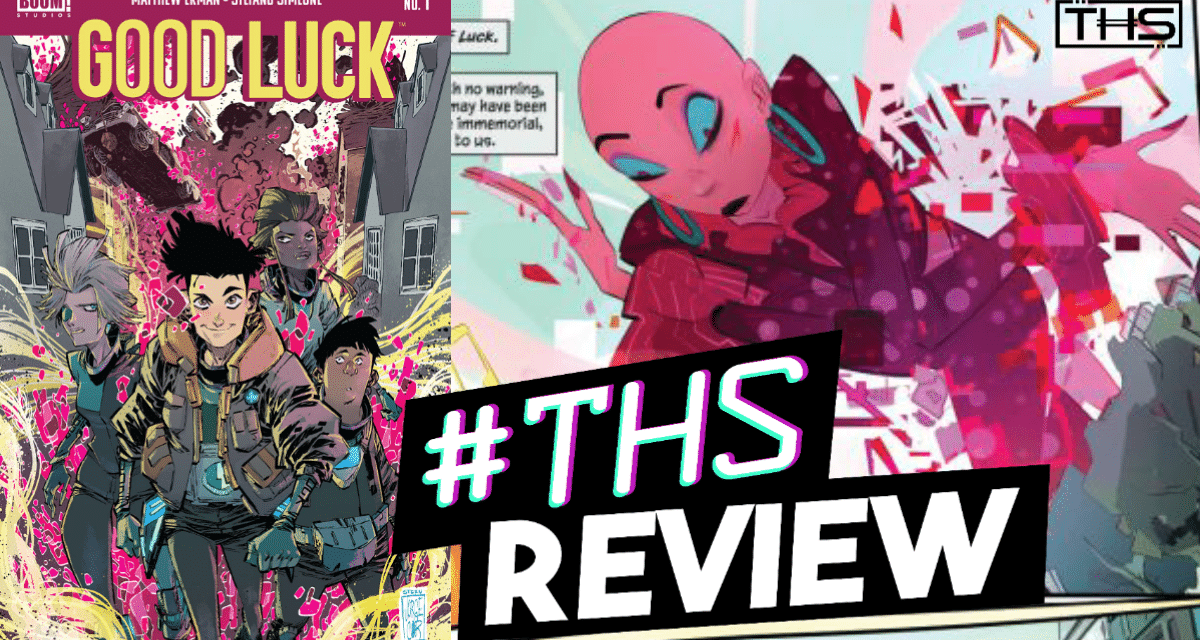Good Luck #1 introduces us to a strange and unique world. One where luck is now a quantifiable figure.

Good Luck is a new…science fiction? Fantasy? Eh, science-fantasy comic book from BOOM! Studios. This particular series will run for a total of 5 issues. Matthew Erman (Witchblood, Power Rangers: Sins of the Future) is the writer for this series. Stefano Simeone (Mega Man: Fully Charged) serves as the artist here, and Mike Fiorentino is the letterer. Jorge Corona (Wynd), Gerald Parel (Symbiote Spider-man: King in Black), and Junggeun Yoon (Magic, Mighty Morphin) did the main cover, and variant covers A and B respectively.

You can purchase Good Luck #1 now for $3.99. You can purchase print copies at your local comic book store for that sweet, sweet paper feel. Or, if you’re fine with the digital version, you can find it on content providers like ComiXology, iBooks, Google Play, and Kindle.

Warning: spoilers for Good Luck #1 below. If you’re interested in seeing how a luck-based society would look like, stop here and come back once you’ve found out for yourself.
Good Luck #1: Plot Summary

The basic premise of the world of Good Luck is that it was your bog-standard, normal, mundane world. And then one day, in a place called Little Kentucky in the state of Ohio, a pair of gods descended upon the small town. One was a god of luck, and the other was a goddess of misfortune. After spreading a bunch of chaos around by tossing extreme good and extreme bad luck around at random, they come into contact with each other and something happened. They never really say what, but they heavily imply that it’s bad. Reality-breaking levels of bad.
Good Luck #1 then jumps ahead 30 years into the future. This new society can measure luck as a quantifiable figure, and basically runs on it. The story then finally introduces us to our hero: Artemis Barlow. Contrary to the origins of his name, Artemis is a guy. He’s also not a hunter, and he’s certainly not like the other fictional Artemis, but I digress. Artemis is a person with no luck. What this means is that unfortunate things keep happening to him, but he’s not unlucky enough to die from those misfortunes.
This is why he’s the protagonist of Good Luck. Apparently, Little Kentucky is some kind of quarantine zone now, and the government wants to find out what’s in it. However, there seems to be a problem with sending in naturally lucky people to do it. So the government has to take people with no luck (called the Unfortunates), and train them for the mission. The end of this comic book sees our hero and his team complete their training mission, and they set off towards Little Kentucky. The very end though reveals that one of the team apparently has something to do with the Luck god and Misfortune goddess still in the town. I guess we’ll just have to find out what in the next issue.
Good Luck #1: The Good

The first thing about Good Luck that jumps out at you is the art. The whole comic book has a very distinct art style. It’s as colorful as it is zany, as you can see above. It creates an art style that catches your attention, and is very pleasing to the eye to look at. This is one of the big pluses for this comic book, in my opinion. Given the visual medium comic books reside in, good art is always going to be a big factor for them.
Another good thing about Good Luck is its setting. It has this almost-dystopian vibe to it. When luck become a quantifiable figure, everyone wants to take advantage of and use it. Thus, it shapes the society, and the result in this.
And lastly, Good Luck has a likable protagonist in the form of Artemis Barlow. You won’t believe how many potentially good stories have been ruined because of an unlikable protagonist. A good protagonist will carry your story far, just like Edward Elric in Fullmetal Alchemist. I just like the kind of character Artemis is. He is optimistic and laidback, in spite of his unluckiness. He’s also a pretty friendly sort, especially towards the underdog of his team. He seems like he would be a good buddy, and I like that in a character.
Good Luck #1: The Bad

It’s hard for me to find anything meaningfully bad to say about Good Luck #1, so I’ll have to nitpick here. I kinda wish the luck-based society got a bit fleshed out more. It would’ve been nice to see more of how people’s lives have changed in response to luck being something you can measure now. It would’ve also been nice to see luck get some kind of fictional base unit here. Maybe they’ll do that in the next issue.
Conclusion
Good Luck #1 introduces us to a luck-based society where luck is something quantifiable. Oh, and it introduces us to a rather likable protagonist too. Interested in this new science fantasy comic book series from BOOM! Studios? Check it out now!
Source: BOOM! Studios


![Star Wars: The Mandalorian – Boba Fett (on Throne Statue) Wants To Rule Over Your Collection [Review]](https://thathashtagshow.com/wp-content/uploads/2024/01/The-Mandalorian-Boba-Fett-Throne-Thumb-440x264.jpg)


